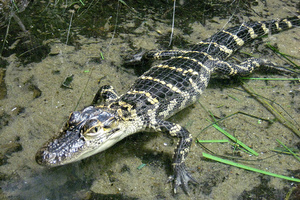Alligator mississippiensis
During periods of drought, "gator holes" (deep areas wallowed out by alligators) are important to the survival of individuals of many aquatic animal species.
Photo Credit: Wally Gobetz
Alligator mississippiensis
Common Name: American alligator
Animal Guild: Reptile
Class > Order > Family: Reptilia > Crocodilia > Alligatoridae
What does the species look like?
American alligators are blackish on top. The young have bold yellowish crossbands that may persist inconspicuously into adulthood. The broadly rounded snout lacks conspicuous upward-protruding teeth. Maximum total length is about 19 feet (5.8 meters), but alligators today are generally 13 feet (4 meters) or less. Males grow much larger than do females. Total length is about 8-9 inches (21-23 cm) at hatching. This species differs from the American crocodile in having a broader snout and in not having the 4th lower jaw tooth protruding conspicuously upward near the end of the snout (tooth may be inconspicuous in small crocodiles). It differs from the spectacled caiman in lacking a curved, bony, crosswise ridge in front of the eyes.
Where is the species found?
States & Provinces
AL, AR, FL, GA, LA, MS, NC, OK, SC, TX
Distribution
Range extends from coastal North Carolina to the Florida Keys, and west to southern Texas, north to southeastern Oklahoma and Arkansas.
American alligators inhabit fresh and brackish marshes, ponds, lakes, rivers, swamps, bayous, canals, and large spring runs. They often bask on partially submerged logs or on land next to the water.
General Phenology and Life History
Alligators dig dens in river or lake margins or in marshes; they spend cold winter and drought periods in the den. In the northern part of the range, alligators are generally inactive or at least less active from about late November to March. Spring courtship involves loud bellowing and slapping of the head against the water surface. Copulation occurs in shallow water. Reproductive females deposit clutches of usually about 20-60 eggs in May, June, or July (peak in late June-early July in the Everglades, north-central Florida, and Georgia). Large mounded nests made of leaves, mud, rotting vegetation, rocks, or other debris are built in marshes or at lake or river margins. Eggs hatch in about 9 weeks. The female stays near the nest and may protect it during incubation, and she assists the emergence of the young by opening the nest mound; sometimes she carries the young in her mouth to water. Hatchlings may stay together in the vicinity of the nest and mother for 1-3 years.
Which phenophases should I observe?
Do you see/hear...?
Activity
Individuals on land More...
For abundance, enter the number of individual animals observed in this phenophase.
Individuals in water More...
For abundance, enter the number of individual animals observed in this phenophase.
Feeding For abundance, enter the number of individual animals observed in this phenophase.
Reproduction
Adults vocalizing For abundance, enter the number of individual animals observed in this phenophase.
Development
Young individuals For abundance, enter the number of individual animals observed in this phenophase.
Dead individuals For abundance, enter the number of individual animals observed in this phenophase.
What do these phenophases look like?
There is currently no photoguide available for this species. If you'd like help us create one, use the guidance document and species template provided here . Then send it via email to education@usanpn.org when it is complete.
